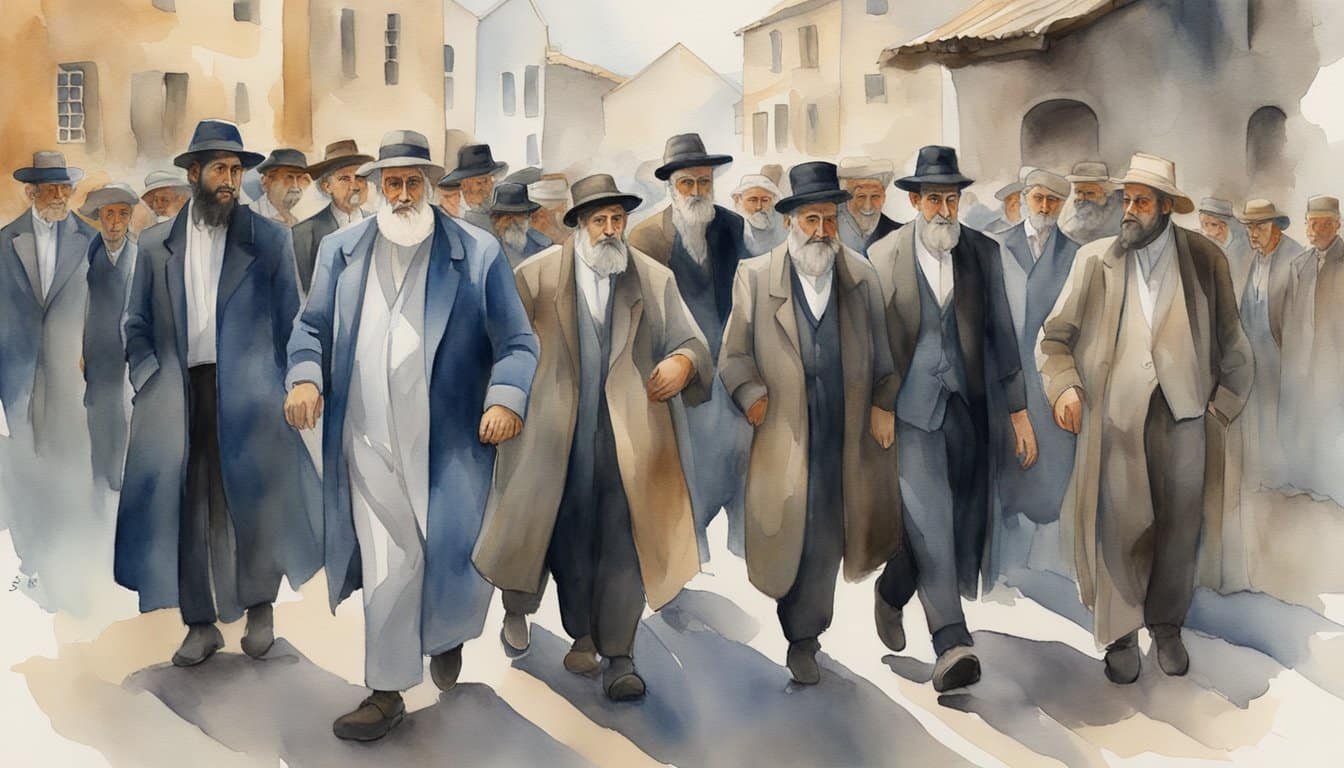Historical Genesis of Ashkenazi Jews
Tracing the roots of Ashkenazi Jews unfolds a tale of migrations, cultural evolution, and linguistic developments that weave through ancient civilizations to the Middle Ages.
Ancient Origins and Migration Patterns
The journey of Ashkenazi Jews began with movements from the Levant, an expansive region in the Eastern Mediterranean. Early Jewish communities dispersed across the Roman Empire, including areas of what is now Italy and other parts of Southern Europe. An intriguing hypothesis suggests links to Iranian Scythians and even those from the Near East regions like Anatolia. Over various historical stages, ancestors of what would be known as Ashkenazi Jews possibly mingled with Slavs, Germans, and other populations in central and eastern Europe. Analyzing ancient genomes shed light on how these mixtures could have come about, presenting a complex tapestry of Irano-Turko-Slavic origins.
A notable shift occurred as some Jewish communities began settling in the Rhineland of modern-day Germany during the first millennium, specifically by the eleventh century. The town of Ashkenaz became symbolic of this Jewish presence in the Rhineland, precipitating the broader identification of Ashkenazi Jews.
Formation of Distinct Ashkenazi Culture in Medieval Europe
As the centuries progressed, Ashkenazi Jews established a pronounced distinctiveness within their settlements in the Middle Ages, particularly in regions of Germany and France. The evolution of Yiddish, a Germanic language written in the Hebrew alphabet and suffused with Hebrew and Slavic elements, evidenced the unique cultural synthesis occurring. It served as a vibrant linguistic thread connecting Ashkenazi communities spread throughout Europe.
During this period, despite facing numerous challenges including periods of severe persecution, they contributed significantly to the cultural and intellectual fabric of European society. Their religion and practices adapted, as discerned by contrasting the Greco-Roman history of Judaism with the medieval Ashkenazi experiences, reflecting both continuity and change from Levantine origins to a more complex Jewish Diaspora in Europe.
The Ashkenazi Jewish identity, encapsulated within the heartland of Medieval Europe – with its own customs, traditions, and intellectual pursuits – became an integral element of Jewish history. The growth of this community through the Middle Ages set the stage for their significant contributions to Jewish thought as well as broader European culture.
Cultural and Religious Life

Ashkenazi Jews have cultivated a rich tapestry of culture and religious observances that span centuries, deeply rooted in the Hebrew language and Jewish identity, while also embracing science, philosophy, art, and scholarship.
Language and Literature
Ashkenazi Jews have traditionally used Hebrew and Yiddish. Hebrew, central to Jewish liturgy, derives unique pronunciation nuances among Ashkenazi communities, differentiating it from other Jewish groups. Literature plays a vital role in the Ashkenazi diaspora, documenting philosophies and illuminating their scholarship and contributions to a variety of scientific fields.
Religious Customs and Differences
Religious life is characterized by specific customs such as distinctive prayers called Selichot, and dietary laws regarding kitniyot and chametz. The cuisine, featuring items like chopped liver, is a reflection of their culinary adaptations. While mainstream Ashkenazi Jews adhere to Rabbinic Judaism, some, like the Karaites, follow a form of Judaism based on Scripture alone, eschewing Talmudic laws.
Historical Challenges and Community Resilience

Ashkenazi Jewry has navigated through trials by leveraging their strong communal bonds and cultural tenacity. Their resilience has notably shaped their collective identity and unfolding diaspora narratives.
Persecutions and the Crusades
The medieval era subjected Ashkenazi Jews to recurring persecutions and significant hardships, particularly during the Crusades. Jewish communities in areas such as the Rhineland were decimated, and these events saw the beginning of extensive migrations eastward into Poland and Lithuania.
The Holocaust and Aftermath
The Holocaust was a devastating atrocity that annihilated a significant portion of the Ashkenazi Jewish population. Post World War II, Ashkenazi Jews were central to founding Israel, with survivors and their descendants contributing to the burgeoning Jewish state’s cultural and genetic tapestry and rebuilding their communities in lands new and old.
Contemporary Ashkenazi Jewish Diaspora
Today, Ashkenazi Jews form a vibrant mosaic across the globe, especially in places like North America and Israel. While the American Jewish community features a dynamic blend of religious life and secular tradition, intermingling with larger dynamics of migration and modernity continues to redefine and strengthen Ashkenazi identity and community bonds.

